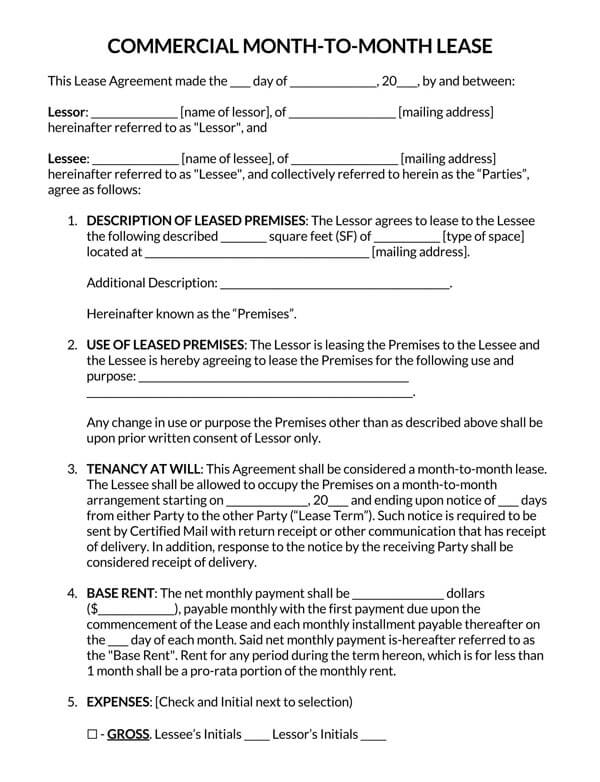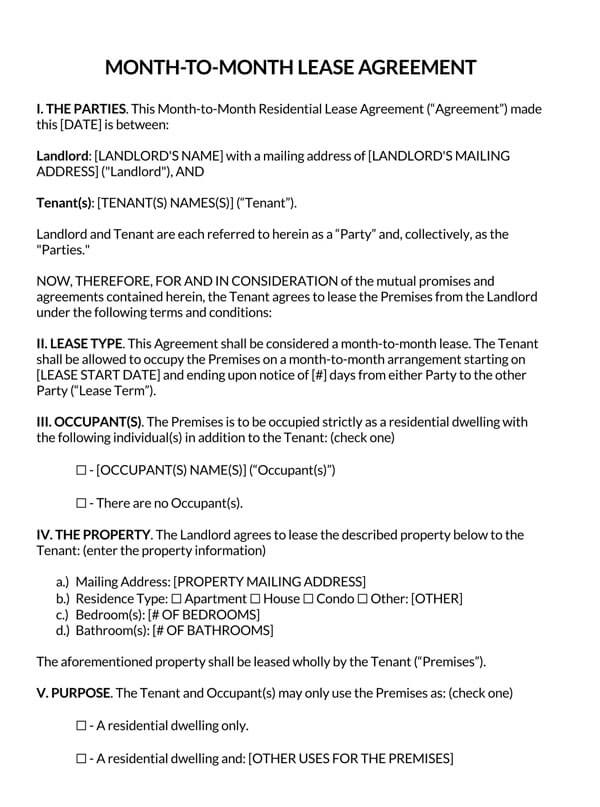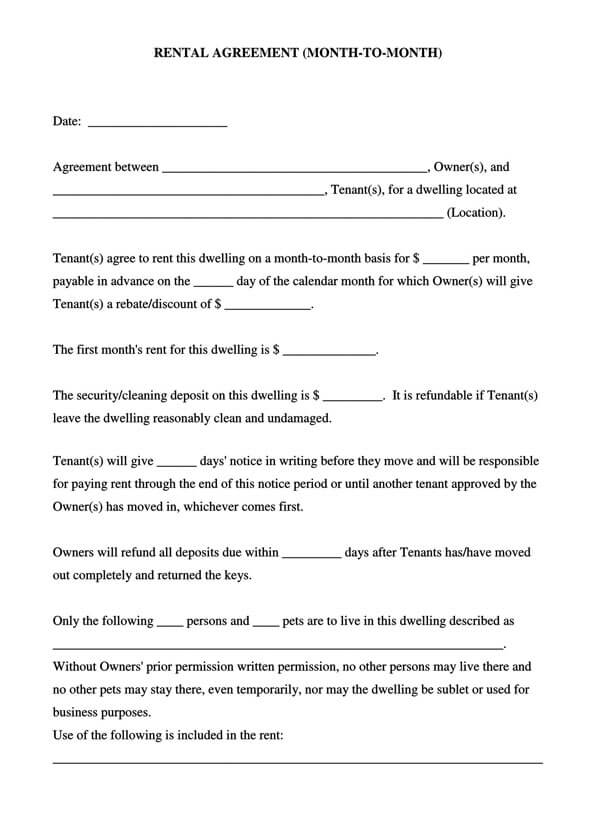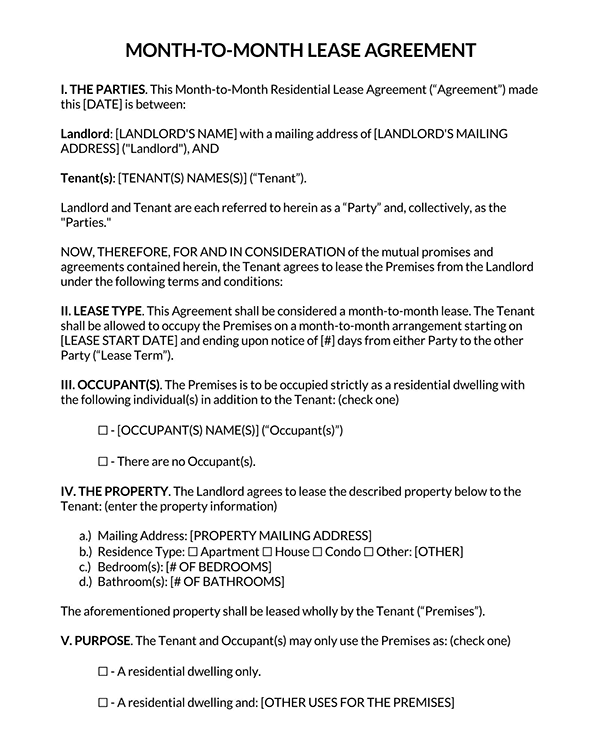A Month-to-Month Rental Agreement is a contract used by landlords to lease property to a tenant one month at a time for an unspecified period at a defined monthly rental amount.
The agreement also allows the termination of the lease and modification of terms with a 30 days’ notice by either party. The agreement/contract is renewed at the end of every month until one party decides to terminate the lease with a written notice. The landlord will normally require tenants to submit a rental application before entering a month-to-month rental agreement.
A month-to-month rental agreement is alternatively referred to as:
- Tenancy-at-will
- Rental agreement
- Periodic tenancy
Types of Month-to-Month Rental Agreement
There are different types of month-to-month rental agreements.
Some of them are as follows:

Commercial Month to Month Lease Agreement
Download: Microsoft Word (.docx)

Residential Month to Month Lease Agreement (Comprehensive)
Download: Microsoft Word (.docx)

Simple Month to Month Rental Agreement
Download: Microsoft Word (.docx)
Pros and Cons of Using the Agreement
A month-to-month lease can be ideal for one’s property or not, depending on its pros and cons. This article looks into the various pros and cons associated with monthly periodic leases.
Following are some pros and cons of using a month-to-month rental agreement:
| Pros | Cons |
|---|---|
| Has flexible end dates as it can be terminated with short notice (30 days). As a result, landlords have more control over their property and are not tied to long-term leases with fixed rental charges. | Creates uncertainty in regards to when the tenant will terminate the lease. As a result, landlords end up having a fluctuating supply of tenants as tenants can come and go as long as they give a 30-day notice. |
| Offers higher rental rates and the ability to increase rent with notice. Landlords can increase rent with a 30 days’ notice as they see fit. | Gives the landlord short notice to find replacement tenants after termination. A landlord can thus be stuck with empty houses now and then as tenants move out on short notice while searching, and screening tenants will normally take time. |
| Offers peace of mind as tenants can terminate the lease soon as they are unable to pay rent. This way, landlords can get rid of unsuitable tenants with the formalities seen in long-term leases. | Provides a less stable rent income. There are no assurances that the existing customers will lease the property for a given period, unlike a long-term lease. Income can then fluctuate and when tenants are moving out on short notice. |
How to Rent Out the Property
A month-to-month rental agreement is, on some occasions, used to extend a long-term lease after it has expired. However, it can be implemented from the onset of the tenancy. The agreement outlines the term of the lease like any other lease agreement, and it will generally have the following clauses; security deposit requirements, rental amount, penalties for late payments (default), and applicable policies or house rules. The guide provided below can be followed by landlords opting for a month-to-month lease on their property.
It includes the following steps:
Step 1- prepare the property
Impressions are essential when it comes to persuading tenants to rent a property. Before having potential tenants view the property, clean the place, furnish (optional), take quality pictures, and list the property online.
Step 2- screening process of applicants
Interested parties will reach out. To find the most suitable applicant, screening is necessary. Enquire about their rental history, income verification, and criminal background and credit checks. Use information obtained from criminal and background checks to select a suitable applicant.
As a landlord, one should come up with criteria for screening tenants. The following demographics should not be used as criteria; gender, race, religion, disability, and familial status. Avoiding these qualities helps a landlord avoid a biased and discriminatory screening process. It is worth noting that the applicant’s income can sometimes be enough to cover monthly rent, all while having bad credit; landlords can reach out to the applicant’s employer to verify the applicant’s status through an employment verification letter.
Step 3- negotiations/draft the lease
Next, negotiate with the tenant if they are requesting adjustments to the terms of the lease. At this point, landlords can ask for a security deposit equivalent to a month’s rent. Depending on the risks associated with a specific tenant, negotiate for terms that protect you from any unprecedented events such as default. Tenants with high-paying jobs have a lower risk as they are more likely to pay rent on time and are therefore are better positioned in negotiating terms. Tenants with poor credit present a higher risk, and as a result, landlords are advised to ask for an equivalent of 2 months’ rent or the state’s maximum limit as insurance in case the tenant is unable to pay rent.
Step 4- writing the lease
Once the rental terms have been agreed upon, the landlord should proceed to create the rental agreement. The rental agreement will outline the contractual obligations of each party and any pertinent information such as identification information.
The items on the agreement should be provided as follows:
Declaration of the lease
The first item on the agreement is a declaration that identifies the two parties that are bound by the agreement. It indicates the agreement is between the landlord and the tenant by identifying each with their official names. The effective date or date when the document was created should be provided.
Property information
The agreement should then identify the property being leased on a month-to-month basis. Indicate the street address location, the city, and state where it is located. The house/unit number can also be provided.
Term of lease
The landlord should then state the lease term. Since a month-to-month lease does not have an expiration date, the two items that should appear in this section are the start date and the termination notice requirements. Therefore, declare the first day the tenant is expected to take occupancy and the number of days each party will have to issue a notice before termination, customarily 30 days.
Rent payments
Next, state the monthly rental terms of the agreement. Indicate how much the tenant should pay every month and state the due date before this payment is made every month.
Late charges
The next section addresses the terms of the late charges of the month-to-month rental agreement. In this section, the landlord declares how late payments will be handled. Landlords are permitted to impose a late fee. However, they should provide a grace period – the period after the due date when tenants are given time to make payment before they are subjected to a late fee.
The agreement should show the exact amount charged as a late fee and the number of days awarded as the grace period. State that non-payment after the grace period will be termed as defaulting and the consequences applicable – these consequences should be in accordance with the state laws and fair housing act.
Returned check fee
Sometimes, tenants can pay rent with a check that bounces for various reasons, such as Insufficient funds. The agreement should state the exact amount the tenant will be penalized for submitting insufficient funds check.
Security deposit
Security deposit is the amount of money requested by a landlord as security if there are damages to the property when the tenant is moving out. The exact security deposit to be received should be stated. In addition, it should be specified whether there is a return policy dependent on security deposit state law requirements.
Default period
Next, the agreement should state the number of days a tenant will have to remedy a default or violation of any lease terms after being issued a notice of default. This is normally a requirement by many local jurisdictions. The number of days the landlord has to wait for the tenant to respond after issuing a notice should also be stated.
Occupants and sublease option
The agreement then declares how many occupants will be living with the tenants and whether the agreement allows subleasing or not. Occupants are any residing individuals who are not bound by the rental agreement. Applicable subleasing terms should be outlined in this section. Subletting terms indicate if subleasing is allowed, does the landlord has to approve a sublet, and does he or she have to approve a subleasing agreement before it is implemented.
Utilities and services
The next section ought to then outline available utilities in the premises and the party responsible for these utilities and services. Clearly define the landlord’s responsibilities and the tenant’s responsibilities. The agreement should give the tenant to have an option to include any services or utilities not mentioned that a landlord is obligated to. Any utility not indicated in the agreement is assumed to be the tenant’s obligation.
Pet rules
Each hose has its pet policy. Clarify the house rules in regard to keeping pets. Declare if they are allowed or not. Sometimes, pets might be allowed if tenants can pay a specified pet deposit. Clearly state how much each tenant should pay per pet. It is also recommended to declare the type, breed, and a number of pets allowed.
Abandonment
The agreement should state the length of time a tenant can be absent from the property before the situation can be termed abandonment. The number of days a tenant can be absent from the property while having unpaid rent before it can be termed as rent abandonment should also be clear. Under this condition, the landlord can terminate the lease.
Parking rules
Indicate if parking space will be allocated to tenants and under what conditions. Parking might be available per house or per vehicle, clearly indicate. In some circumstances, the tenant has to pay a specified amount to be entitled to parking spaces.
Noise
The agreement should then state the house noise policy in place. This section outlines limiting terms such as when to move furniture, when to host parties, when loud music is prohibited, and other applicable conditions.
Balconies
Balconies are known incentives to tenants. Landlords will often have guidelines regarding the use of balconies; these guidelines should appear in this section. State the activities permitted on balconies and those prohibited, such as grilling, drying fabrics, etc., the usage of balconies also comes at a risk of accidents. The agreement should state safety precautions laid out by the landlord in regard to the use of balconies.
Governing state law
The month-to-month rental agreement should state its jurisdiction by having the name of the state in which the premises/property is located written down.
Display of signs
It is common for landlords to want to market soon to be vacated property before the actual moving out date. In that regard, as a landlord, one should ensure the number of days before the move-out date (termination date) when one can place a sign on the property to seek potential tenants.
Additional provisions
Next, outline any additional provisions (terms and conditions) associated with the month-to-month lease.
Signatures
The last item on the agreement should be the signatures of the landlord and the tenant. Their names should appear after their signatures. Once signed, the month-to-month rental agreement is legally binding.
Step 5-execution of the lease terms
The next step is to have each party fulfill their laid-out contractual obligations. The landlord receives the security deposit and the first month’s rent, and he or she gives the tenant access to the property and a copy of the signed month-to-month rental agreement. Ensure any applicable fees are received before the tenant moves in.
One should ensure they collect the following:
- Security deposit
- The first month’s rent
- Applicable fees such as pet fee or pet fee
- Proration rental amount if the tenant moves in a few days before the agreed move-in date
- Pre-paid rent if applicable.
Step 6- taking occupancy/ moving in process
Lastly, the tenant moves in on the agreed date. Normally moving in is expected on the first day of the month, but tenants can choose to pro-rate (pay rent equivalent for days they intend to move in before the agreed date) the rent and move in earlier. The agreement is now in effect until either party decides to terminate it with notice.
Termination Process of Monthly Rental Agreement
As earlier mentioned, termination of a month-to-month rental agreement has to be done with a written notice. The written notice should have the following; names and addresses of the involved parties, date of notice, reference to the rental agreement, reason for the termination/notice, the signature of the issuing party (landlord). The notice should be delivered with a return receipt.
Required Termination Periods by State Laws
| State | Statute |
|---|---|
| Alabama | § 35-9A-441 |
| Alaska | § 34.03.290(b) |
| Arizona | § 33-1375 |
| Arkansas | § 18-17-704 |
| California | § 1946 |
| Colorado | § 13-40-107 |
| Connecticut | § 47a-23 |
| Delaware | Title 25 § 5106 |
| Florida | § 83.57 |
| Georgia | § 44-7-7 |
| Hawaii | § 521-71 |
| Idaho | § 55-208 |
| Illinois | 735 ILCS 5/9-207 |
| Indiana | § 32-31-1-1 |
| Iowa | § 562A.34 |
| Kansas | § 58-2570 |
| Kentucky | § 383.695 |
| Louisiana | CC 2728 |
| Maine | Title 14 § 6002 |
| Maryland | § 8-402 |
| Massachusetts | § 186-15B |
| Michigan | § 554.134 |
| Minnesota | § 504B.135 |
| Mississippi | § 89-8-19 |
| Missouri | § 441.060 |
| Montana | § 70-24-441 |
| Nebraska | § 76-1437(2) |
| Nevada | NRS 40.251 |
| New Hampshire | § 540:11(2) |
| New Jersey | § 2A:18-56 |
| New Mexico | § 47-8-37 |
| New York | § 232-b |
| North Carolina | § 42-14 |
| North Dakota | § 47-16-07.2 |
| Ohio | § 5321.17 |
| Oklahoma | § 41-111 |
| Oregon | § 91.070 |
| Pennsylvania | § 250.501 |
| Rhode Island | § 34-18-37 |
| South Carolina | § 27-40-770 |
| South Dakota | § 43-32-13 |
| Tennessee | § 66-28-512 |
| Texas | § 91.001 |
| Utah | § 78B-6-802 |
| Vermont | § 4467 |
| Virginia | § 55.1-1253(A) |
| Washington | § 59.18.200 |
| Washington D.C. | § 42–3505.54(a) |
| West Virginia | § 37-6-5 |
| Wisconsin | § 704.19 |
| Wyoming | No statute |
Month to Month Lease Agreement Templates
A month-to-month rental agreement template is a form that has all the sections that should appear on a standard month-to-month rental agreement. These templates are easily downloadable and readily available on our website. Landlords can use the templates to craft the rental agreement instead of drafting the agreement from scratch. The use of templates is as easy as filling out the appropriate information in the appropriate sections.
Standard month-to-month rental agreement template
Templates by State
Frequently Asked Questions
Can a landlord raise rent on a Month-to-Month Lease?
Yes. However, he or she has to notify the tenant with a 30-day written notice of their intent to raise the rent. This process applies to any other modifications made to the month-to-month rental agreement.
What is the difference between Month-to-Month and Fixed-Term Leases?
A month-to-month lease has a set start date and does not have a specified end date, whereas a fixed-term lease has both a start and end date. Month-to-month leases are more flexible, have a more direct tenant removal process, and offer the landlord the ability to increase rent, unlike a fixed-term lease.
Is Month to Month Lease bad?
The suitability of a month-to-month rental agreement is dependent on the landlord’s preference and how it works in his or her best interest. Therefore, its suitability is not defined, and as a result, it changes from one situation to the other.
What happens when a lease goes month to month?
When a lease goes month to month, it means the lease automatically renews every month unless a notice of termination is issued.
Can a rent agreement be made for one month?
Yes. A rent agreement can be made for any unconventional period as long as the landlord and the tenant agree to this term. However, a month-to-month lease agreement would not be applicable in that situation; a week-by-week agreement would be more befitting.
Does a month-to-month lease need to be signed every month?
No. A month-to-month rental agreement is subjected to automatic renewal every month without each party signing the document every month.
